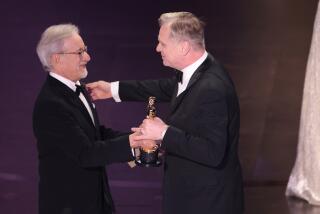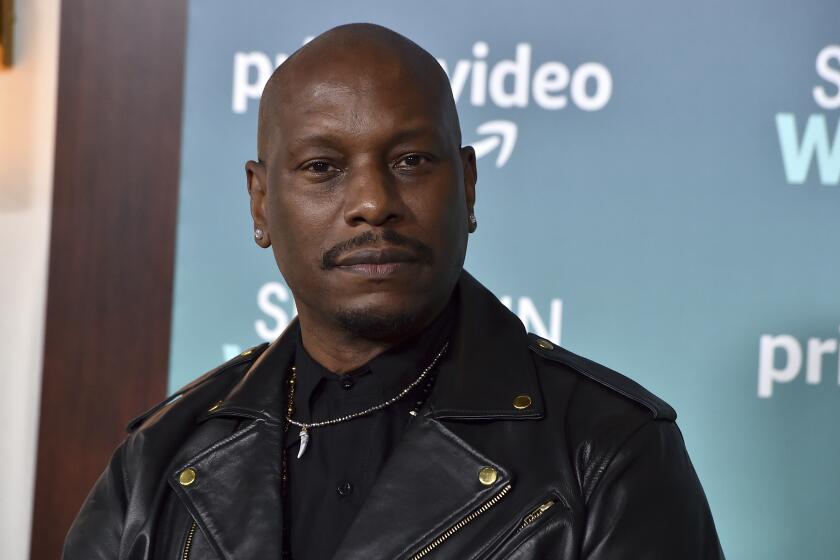From a brilliant field of cinematography Oscar nominees, a critic chooses his ‘Favourite’
When the Oscars are finally (finally!) handed out Sunday evening, you may hear an impassioned comment or two from the stage about the importance of the art of cinematography. Maybe you’ve heard some of them already.
Earlier this month, the Academy of Motion Picture Arts and Sciences announced that the cinematography award — along with the prizes for film editing, live-action short and makeup and hairstyling — would be presented during a commercial break. Filmmakers, critics and various Film Twitter denizens unleashed a storm of outrage so intense that the academy reversed its decision, happily for those of us who still cherish the Oscars and remain foolish enough to believe that they can, on occasion, do the right thing.
Still, there was something heartening about the tributes to cinematography and editing that emerged — indignant reminders that without these basic building blocks, the medium wouldn’t even exist.
The academy is hardly alone in perpetuating this neglect. Critics sometimes review movies as if they were novels, neglecting to note how a picture’s visual style — its composition, its use of color or black-and-white, its camera movement or lack thereof — can shape, enhance or even subvert its meaning. Good editing can be an even harder achievement to describe, since it is so often an art by subtraction, an invisible alchemy that transpires between individual shots and frames.
OSCARS 2019: Full list of Academy Award nominees »
I saw quite a few superbly photographed and edited movies in 2018, including “Black Panther,” “First Reformed,” “Hereditary,” “If Beale Street Could Talk,” “Private Life” and “You Were Never Really Here,” none of which received a nomination in either category.
I’ll suspend further comment on the comparative weakness of this year’s editing category, except to note that “BlacKkKlansman” and “The Favourite” strike me as the sole worthy nominees, while the presumed front-runners, “Bohemian Rhapsody” and “Vice,” offer the kind of jumpy nonlinear narratives that frequently get mistaken for impressive editing rather than choppy screenwriting.
The cinematography race offers a much more satisfying range of possibilities. Best cinematography, quite a few directors of photography will tell you, is too often mistaken for prettiest cinematography.
Certainly the exquisite images in this year’s five nominees — “Cold War,” “The Favourite,” “Never Look Away,” “Roma” and “A Star Is Born” — might seem at first to bear out this prejudice, given that they could furnish five equally gorgeous coffee-table books. In the case of “Roma,” shot in shimmering black-and-white by the director Alfonso Cuarón, such a book actually exists (and being in possession of a copy, I can tell you it weighs nearly as much as my coffee table).
The beauty of Cuarón’s work lies not merely in the depth and sharpness of its widescreen images (achieved on the large-format Alexa 65 digital camera), but also in its skillful use of camera movement and shot duration. In re-creating stretches of the bygone Mexico City of his childhood, Cuarón both continues and departs from the virtuosic, hyper-alert style he developed with his longtime d.p., Emmanuel Lubezki (“Gravity,” “Children of Men”). He enters into the fog of his memories and brings them into crystalline focus.
He likes to survey his protagonist, an indigenous Mixtec woman named Cleo (Yalitza Aparicio) who works as a maid for a middle-class family, from a respectful distance, in gliding long takes that hum and bustle with quotidian activity. When the movie goes in for an occasional closeup, the sense of intimacy is piercing.
It’s undeniably stunning work, its domestic tableaux and urban panoramas containing strong echoes of realist masters like India’s Satyajit Ray, Japan’s Yasujiro Ozu and Taiwan’s Hou Hsiao-hsien.
To these mightily impressed but not entirely enraptured eyes, there remains a self-admiring quality to Cuarón’s imagery that keeps full immersion at bay. Where those earlier filmmakers seemed to enfold their characters in the gentlest of visual embraces, “Roma” has the coolly engineered precision of a social-realist blockbuster: The rigor of the compositions and the choreography often lacks a crucial element of spontaneity, of raw, unvarnished life. It may be the first movie in which Cuarón’s love for his characters feels eclipsed by his love for his technique.
Review: Pawel Pawlikowski’s ‘Cold War’ is a stunning, white-hot romance »
You might accuse Pawel Pawlikowski’s “Cold War,” the category’s other black-and-white nominee, of a similar self-regard. Even a friend who adores this time-skipping, border-crossing Polish romance concedes that its impeccably stylish, high-contrast monochrome at times seems redolent of a Calvin Klein ad.
Still, perfume-commercial aesthetics can be deceptive. And the gleaming patina of Lukasz Zal’s photography turns out to be crucial to the picture’s slippery method, which is to seduce you with ravishing surfaces and then startle you with the depth of its heartache.
Two lovers, Wiktor (Tomasz Kot) and Zula (Joanna Kulig), meet as members of a Polish theatrical ensemble in 1949, and “Cold War,” while not quite a full-blown musical, pays lovely homage to bygone traditions of folk performance. The camera drifts in and among the singers and dancers on stage with an almost narcotic intensity, as though it were trying to lose itself in the grandeur of their music making. But while the movie initially crowds the frame with bodies in expertly synchronized motion, gradually its spaces seem to empty out: The illusion of a bustling communal existence seems to die alongside Wiktor and Zula’s romantic dreams.
As he did with Pawlikowski’s Oscar-winning “Ida” (which he shot with Ryszard Lenczewski), Zal employs a boxy aspect ratio that strikingly evokes the pictures of an earlier era. (Notably, the spare, austere visuals of “Ida” directly influenced Paul Schrader’s “First Reformed.”) It’s the right choice for a movie about characters who seem increasingly isolated from each other and the world around them. The nearly square frame, no less than the battle-scarred continent they keep traversing, becomes a kind of prison.
Rare as it is to see two black-and-white pictures nominated for cinematography, Oscar’s love for monochrome is nothing new, given past nominations for “The Artist,” “The White Ribbon” and “Good Night, and Good Luck.” More noteworthy is the fact that three of this year’s nominees are non-English-language films, a development that may or may not reflect the academy’s growing international membership.
FULL COVERAGE: Countdown to the Oscars »
Still, the historical drama “Never Look Away,” from German director Florian Henckel von Donnersmarck, speaks in a visual syntax that could hardly be more accessible. Its pristine, immaculately lighted images, shot by the much-Oscar-nominated Caleb Deschanel (“The Passion of the Christ,” “The Right Stuff”), pull you effortlessly into a dense, sweeping narrative that consumes three hours of screen time and plays out over three decades.
The polished classicism can feel at odds with the ugliness of what we see — the horrors of World War II and a divided postwar state — and also with the story itself, which concerns a painter (Tom Schilling) who is seeking more abstract, modernist forms of expression. But that contradiction feels like a fascinating provocation, as if the movie were trying to defend the worthiness of its characters’ ideas without necessarily duplicating them. You could think of Deschanel’s images as a frame in the sense of not just a movie, but a painting — a clean, decorous structure that invites us to look closely at the more radical stuff going on inside the margins.
The restless visual style of Bradley Cooper’s “A Star Is Born” remake is wilder and more unruly, though no less skillfully controlled. Its versatile d.p., Matthew Libatique, received an Oscar nomination for “Black Swan,” and while “A Star Is Born” is more doomed romance than psychological freakout, its flowing camerawork seems to echo that earlier movie — as well as “Cold War” — in using the thrill of a live performance to pull us deeper into an intimate backstage drama.
The movie’s most memorably electrifying sequence finds Jackson bringing Lady Gaga’s still-unknown Ally out to perform her new song, “Shallow,” before an audience of thousands. But the camera takes little notice of the crowd or the accompanying concert pyrotechnics. Instead it hovers gently on stage, cutting between its two leads as they pass a crucial point of no return. You see the loving confidence on Jackson’s face and the mix of anxiety and exhilaration on Ally’s, underscored by the arena lighting and its steady oscillations between cool greens and warm reds.
Notably, we feel as close to the characters in this very public encounter as we do in an earlier scene, in which Ally first sings “Shallow” for Jackson in a parking lot, illuminated by the fluorescent beams of a convenience store. It’s a lovely moment notable for the stillness of the camera; the frame will later churn with violent emotion as the lovers come together and come apart, and a private domestic drama becomes its own up-close-and-personal spectacle.
The Envys: The film awards you didn’t see coming »
The camera seems to be in even more continuous motion in “The Favourite,” Yorgos Lanthimos’ superbly biting tragicomedy set in the 18th century court of Queen Anne (Olivia Colman). Shot entirely with natural light on lustrous 35-millimeter film by the Irish cinematographer Robbie Ryan (“American Honey,” “Slow West”), the movie draws us into a world of jaw-dropping palatial splendor and impenetrable nighttime shadows. The result is the most sumptuous of the five cinematography nominees, but also the most dynamic: Its candlelit mise-en-scène has the whirling velocity of a coked-up “Barry Lyndon.”
As Anne and her closest consorts (played by Emma Stone and Rachel Weisz) enact a series of power plays, the camera whisks us from room to room, vaulting across the queen’s lavishly appointed bedchamber and chasing the characters down endlessly long corridors. There are slow, creeping zooms and jarring 180-degree rotations. The action is periodically distorted by wide-angle lenses, literalizing our sense of this ritualized world as an oversize fishbowl. Then again, the more fitting allusion may be to “Through the Looking-Glass”; Lewis Carroll knew a thing or two about mad queens and elaborate chess moves.
If “The Favourite” strikes me as the most accomplished of the cinematography nominees, it’s because at every moment Ryan’s darting camera seems to be serving Lanthimos’ myriad ambitions. It supplies a bracing visual equivalent of the script’s verbal energy. It shows us the halls of power in all their high-toned absurdity and cavernous beauty. It gives fascinating visual shape to the emotional forces ricocheting among the three leads. And on a frame-by-frame basis it is, yes, exceedingly gorgeous to look at.
Most of all, it seems to knock every speck of dust from a genre too often subjected to stiff pageantry and gratuitous opulence. In that respect it does what so much great cinematography does: It shows us a familiar world through new eyes.
More to Read
Only good movies
Get the Indie Focus newsletter, Mark Olsen's weekly guide to the world of cinema.
You may occasionally receive promotional content from the Los Angeles Times.











